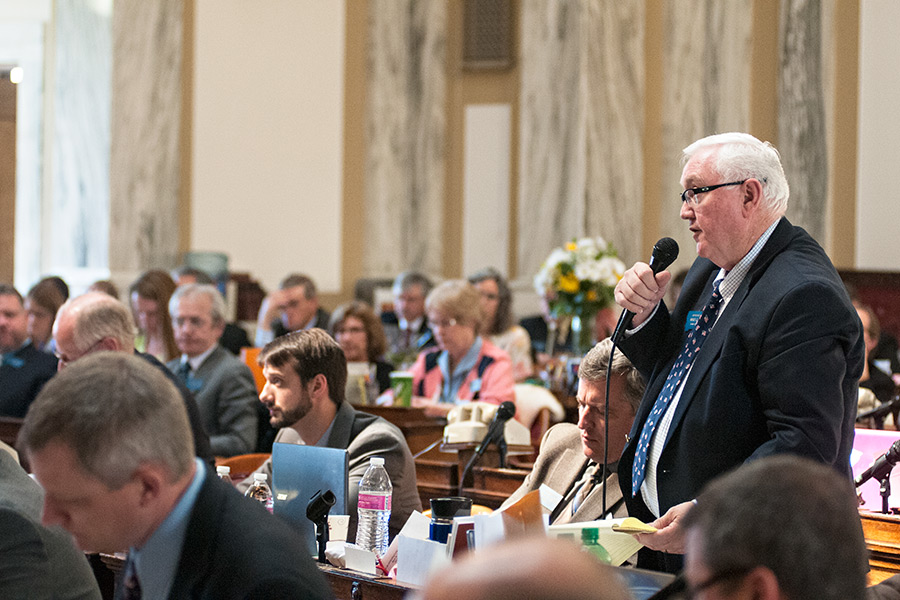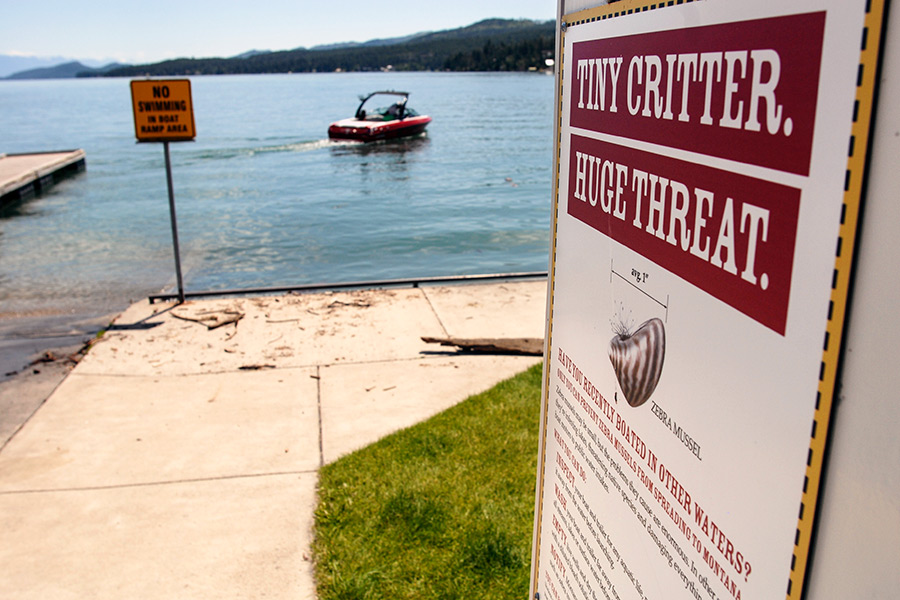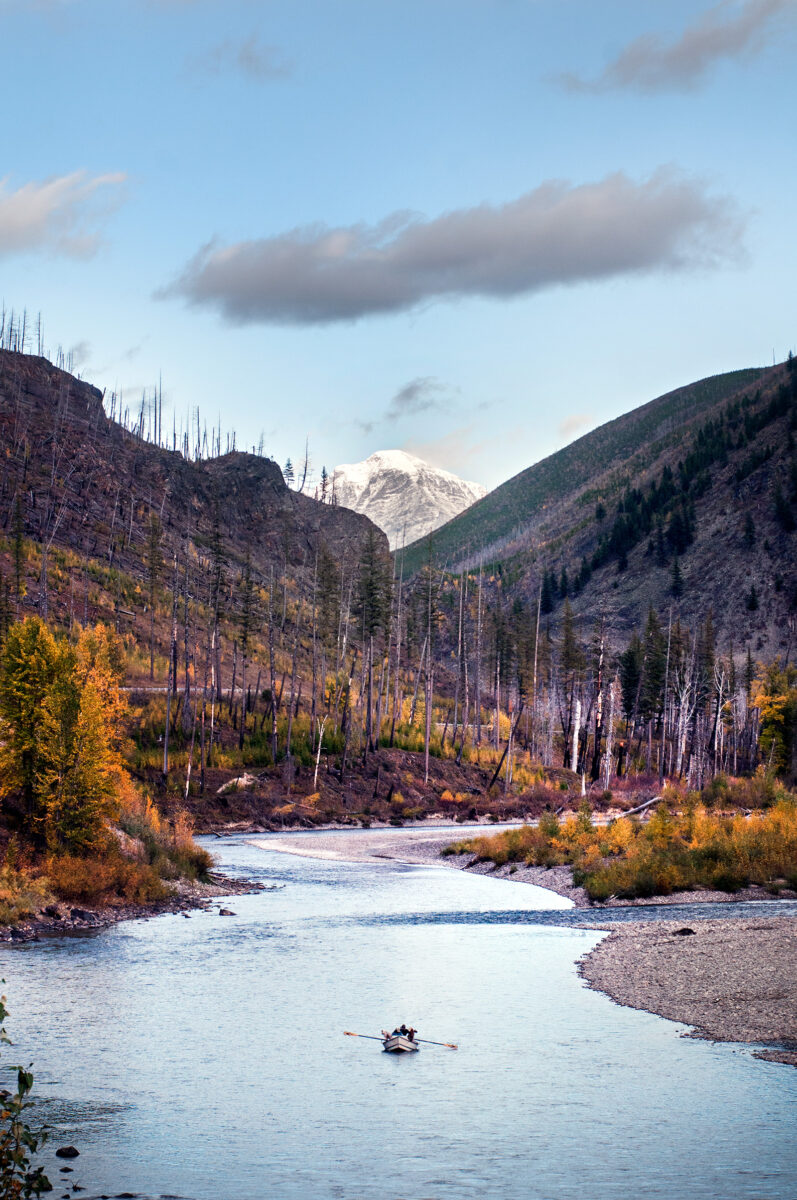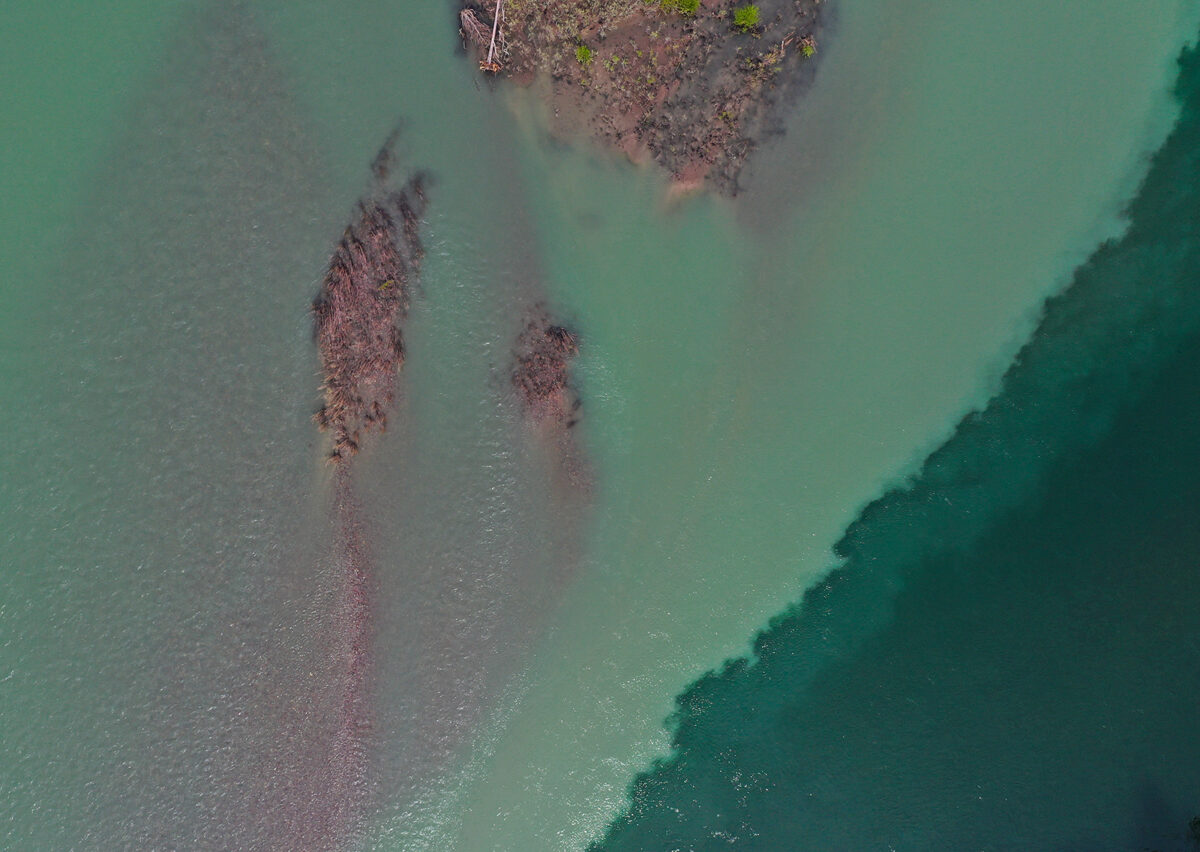A New Water Quality Watchdog for Western Montana
Four decades after its creation, the Flathead Basin Commission is poised to integrate with a new region-wide commission. Despite concerns that the merger will dilute focus on the critical headwaters, state administrators describe the new commission as “leaner and meaner.”
By Tristan Scott
Four decades ago, when Montana’s state government created the Flathead Basin Commission to safeguard its waters, invisible coal deposits lay concealed in the wilds of British Columbia, untapped and untouched. They ran in seams beneath a skinny track of wilderness just north of Glacier National Park, at a site overlooking the Canadian Flathead River, which spills south, crosses the international boundary, and becomes the North Fork Flathead River.
Against all odds, that coal remains hidden today, still entombed in the strata, due in large part to a grassroots campaign engineered by the region’s foremost water-quality watchdog group. But even as the transboundary Flathead enjoys permanent protections from future mining or drilling, the legislatively established Flathead Basin Commission (FBC) is undergoing a dramatic transformation as it fuses with the Upper Columbia Conservation Commission (UC3) to create the new Western Montana Conservation Commission, conjoining the entities’ shared objectives under a single unifying umbrella and, in doing so, eliminating overlap.
That’s the thrust of Senate Bill 83, which the Montana Legislature is set to approve as part of Gov. Greg Gianforte’s “Red Tape Relief Project,” even as lawmakers and administrators for the Montana Department of Natural Resources and Conservation (DNRC) have been angling to combine the powers and expand the horizons of the two oversight groups for years, starting under former Gov. Steve Bullock’s administration.
“The genesis of this concept came from conversations we were having even before Governor Gianforte was elected. It began because we had a vision of forming something that did Flathead Basin Commission-type work, but on a regional scale,” said Mark Bostrom, DNRC’s Conservation and Resource Development Division (CARDD) administrator and an ex-officio non-voting member of the FBC. “There were initiatives that FBC wanted to be involved in beyond its local watershed, but statute said its focus was confined to the Flathead. So, during the pandemic when we started seeing all this federal money coming out of Biden administration, we thought now might be the perfect time to take this thing into the major leagues.”
Although the merger has generated some concern among stakeholders who worry the drainage-specific focus on the Flathead Basin will be diluted — and its grassroots autonomy commandeered — even longtime members of the 40-year-old commission say it’s not only a logical move, but a beneficial one.
“We feel like this combined commission serves those dual missions well,” said Clayton Elliott, conservation and government affairs director for Montana Trout Unlimited, told members of the House Natural Resources Committee, where it passed unanimously. The bill also received unanimous support at separate House floor hearings and now awaits a Senate vote

For Tom McDonald, chair of the Confederated Salish and Kootenai Tribes (CSKT) who worked closely with both the FBC and the UC3 during his tenure as division manager of the Tribes’ Natural Resources Department, the organizations were critical partners in efforts to combat the threat of aquatic invasive mussels, particularly in 2016 when the specter of that threat materialized on the doorstep of the Columbia River Basin.
“That was a wake-up call for us, and for the entire state,” McDonald told the Beacon. “We were really worried that there was not enough emphasis on coordinating resources between the various state agencies, even when the threat was standing right in front of us. But those state agencies have since stepped up to the plate. I have a confidence in them now that I didn’t have some years ago. It’s a different day today and we know what we have to do to protect ourselves.”
Both locally and statewide, efforts to reduce the risk of aquatic invasive species spreading through Montana’s water bodies were intensified beginning in the fall of 2016 in response to the positive detection of invasive mussel larvae east of the Continental Divide in Tiber Reservoir, as well as their suspected presence in Canyon Ferry Reservoir and the Missouri River near Townsend. Facing the threat of invasive mussels infesting the headwaters of the Columbia River and the largest freshwater lake in the West, the state of Montana — with prodding from the Flathead Basin Commission — ramped up its protective measures west of the Continental Divide.
Out of those protective efforts grew the UC3, which, like the FBC, was administratively attached to the DNRC when it formed in 2017 to coordinate AIS check stations and expand education and outreach efforts. In the ensuing years, however, with some of its functions attaining a degree of self-sustainability, officials say the twin commissions have become redundant.
“Since then, the UC3 and the FBC have both shared common staff, offices, partners, stakeholders, and are constructed on a similar commission model,” Bostrom said. “The natural resources mission and duties of the FBC are broad and have historically included AIS, but it’s confined to the Flathead watershed. Conversely, UC3 had a narrow mission focused on AIS, but its scope was on the entire west slope. So, practically speaking, a single commission with the mission and duties of the FBC applied at a geographic scale of the Upper Columbia Conservation Commission can serve the combined goals of both.”
For as long as Mike Cuffe has been a state lawmaker, the Republican senator from Eureka, who sponsored SB 83, has been carrying around a mussel-fouled boat propeller and a piece of irrigating equipment choked with popcorn-kernel-sized mussels to illustrate the devastating consequences an infestation can have on a watershed, as well as on a region’s economic and environmental health. An infestation of zebra or quagga mussels could spell the beginning of the end for Montana’s most pristine watersheds, Cuffe warned, with the potential to topple underwater food webs that prop up the Treasure State’s prized aquatic species while wreaking untold havoc on its infrastructure and recreation economy.

Although they’ve never taken root here, invasive mussels have arrived for years at check stations, carried by unassuming boaters hailing from infested waterways, a lesson in vigilance that underscores the need to bolster the state’s perimeter-defense strategy.
“Aquatic invasive species have become a centerpiece of my legislative career,” Cuffe said. “I kind of ended up leading the charge and it became a passion of mine. I’m passionate about keeping our streams and rivers clean and prevention is the only way.”
In 2017, after Cuffe’s chicken-little scenario came into dire focus just across the Continental Divide from the headwaters of the Flathead River basin, he set to work on a bill that would coordinate AIS monitoring resources from Butte to Whitefish and “give them a united focus,” he said.

“You call this a bill, but I call it my baby,” Cuffe told members of the House Natural Resources Committee last month when he introduced SB 83. “I brought this little guy into the world. But ifyou remember 2017, you remember we were living in a different world. We had just discovered the likelihood of what we believed to be a population of zebra or quagga mussels in Tiber Reservoir, and also Canyon Ferry, both within sight distance of the Continental Divide. On the other side of the Divide is the Columbia River drainage, which is the only major drainage in the U.S. that is free of mussels. And we wanted to keep it that way. We wanted to create a firewall across the Continental Divide to prevent mussels from going across and we went after it very seriously. And the Upper Columbia Conservation Commission was a main part of achieving that objective. So was the Flathead Basin Commission. But when some of the folks in the governor’s office were beginning to look at red tape reduction and they came up with this idea to combine these two commissions, it made a lot of sense to me. In no way do I mean to denigrate the folks who have served in UC3. It has served its purpose and it has served its purpose very well. But it’s grown up,and we can say it was successful. Now it’s time to put it in combination with the Flathead Basin Commission and expand their horizon a little bit.”
Under the new Western Montana Conservation Commission, the horizon would expand to include the Kootenai River, the upper and lower Clark Fork River and the Bitterroot River, as well as a host of other drainages and tributaries.
Still, as the Intermountain West records unprecedented population growth and Montana ties with Utah as the fastest-growing state in the nation, with Flathead County growing its population by 15% in the past decade, some worry that a blended commission won’t have the wherewithal to keep tabs on the Flathead.
Samantha Tappenbeck, resource conservationist for the Flathead Conservation District, whose Board of Supervisors voted to formally oppose SB 83, worries that expanding the horizons of the Flathead Basin Commission could diminish its focus on a unique and multi-dimensional watershed just as it squares off against unprecedented development pressures.
“The focus of FBC has shifted over time in response to emerging threats to water quality and concerns brought forward from stakeholders and representatives that make up the Commission,” Tappenbeck said.
Not only did FBC lead the charge in implementing policy that prevented the development of Canadian open-strip coal mining operations on the transboundary North Fork Flathead River, but it also drew attention to the threat of oil trains transporting hazardous materials on the Middle Fork Flathead River. In recent years, its focus has shifted again to include addressing nonpoint source pollution in the Flathead Basin.
“The waters flowing out of the three forks of the Flathead River hit the Flathead Valley where there are unprecedented rates of growth and development. The state of Montana has no regulatory authority over nonpoint source pollution, which amounts to death by a thousand cuts for water quality,” Tappenbeck said. “The FBC has stepped up to create education and awareness campaigns and resources about the importance of water quality which people can connect to. They have also developed and implemented programs that directly address stormwater management and septic leachate pollution.”

Susan Teitelman, of the Flathead Lakers, similarly expressed concerns to legislators that adding watersheds to the new commission’s purview would weaken its focus on the Flathead.
“Because this will increase the scope of the work, we are concerned with how the geographic expansion would be staffed and funded,” Teitelman told committee members last month.
Casey Lewis, executive director of both the UC3 and the FBC, is now poised to lead the Western Montana Conservation Commission and said her time working as the environmental coordinator for the city of Kalispell, where she still lives, has made her fiercely protective of the Flathead Basin.
“I am particularly sensitive to the concerns about diluting the impact on the Flathead, both because of my former role working with the city as well as my relationship with the Flathead Basin Commission,” Lewis told the Beacon. “I think it’s going to be important that we take a smart approach to the expansion and continue the partnerships we developed and support in the area so that we don’t lose that, and I hear where these concerns are coming from. But it’s written into the statute that there will be a continued focus on the Flathead and there are a lot of other benefits to this expansion, including being able to draw from a greater pool of partners and people, as well as financial resources.”

Those resources include a possible $7 million renewable resource grant from the U.S. Environmental Protection Agency to address nonpoint source pollution — that which comes from oil, pet waste, pesticide, herbicide, fertilizer, road salt, sediment, and any other contaminant that ends up on the ground — and for which Lewis and Bostrom says the newly formed commission is better equipped to be selected given its broader scope.
“With more funding opportunities at the federal level to operate at a bigger scale, we think those dilution-of-focus type questions are going to be answered very soon,” Bostrom said.
Still, as part of a “red tape reduction” initiative, Bostrom and Lewis acknowledge that a bump in funding isn’t part of the arrangement even as the new commission increases its workload. Both the FBC and the UC3 had their personnel services and operational funding tethered to CARDD’s base budget, according to Bostrom.
“The plan is to merge those two for the [Western Montana Conservation Commission] when we set up its budget for the next biennium,” Bostrom said, adding that a rough estimate would allocate the new commission $350,000 in state funds to begin operating with. Most of that funding comes from the FBC, which has a current (FY23) base budget of $283,472.
“Leveraging grants for the new commission will be important,” Bostrom said, adding that the addition of a fourth staff member to help Lewis and her two employees as a “utility player” may be in the cards. “Either, or both, of these scenarios could assuage some of the concern that the effort of the three (existing) staff are being spread too thin. It’ll be tight regardless, but Casey and I will make it work. We didn’t ask for more money to do this thing, that would have defeated the Red-Tape purpose of [the bill].”
If SB 83 passes the Senate and is signed into law by Gianforte, the new law would take effect July 1 with a sunset date of June 30, 2029, allowing lawmakers to re-evaluate the commission.
According to McDonald, chair of CSKT, the new commission’s expanded focus could be a boon not only to the Flathead watershed, but to connected drainages across the region.
“There was overlapping staff and resources between the two commissions, and if you think about what water quality issues the new commission will be focused on, like the New Zealand mudsnails in the Upper Clark Fork, isn’t that an issue that’s connected to the Flathead? You’re damn right it is. We need to have a full-front defense surrounding the Columbia River watershed, because it’s a all connected. You don’t want to build walls or kingdoms, and you don’t need redundant boards and commissions.”